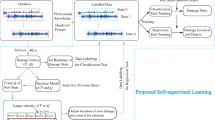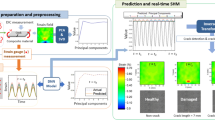Abstract
The maintenance of fatigue damage is essential to keep steel bridges safe since the fatigue crack can lead to brittle fracture. However, real-time monitoring of fatigue crack propagation using traditional strain-based sensors is still a critical challenge due to their limited ductility and durability. In this paper, we propose a fatigue crack monitoring system by employing accelerometers due to their portability, easy replaceability, and sustainability. A corresponding blind source separation (BSS) joint convolutional neural network (CNN) classifier, namely B-CNN, is also proposed to identify fatigue crack conditions by interpreting acceleration measurements directly. We introduce the BSS as the first feature conversion layer to identify the pseudo modal properties from the highly sampled acceleration measurements before any further deep learning progress conducted by CNN. Those converted features are the sparse representation of the structural performance, where the crack conditions are hidden. By adopting BSS, the time history data can be sparse expressed, and the subsequent feature learning could be accelerated by employing a shallow CNN configuration. The proposed B-CNN classifier is further utilized for predicting crack conditions from forthcoming measurements. To examine the proposed monitoring solution, an experimental case study on a steel girder is conducted. About 1-month acceleration measurements were collected and investigated in this paper. The results obtained can demonstrate a shallow B-CNN configuration is sufficient to accurately identify cracks condition with high precision, over 93%, and proper prospection on unseen measurements.

















Similar content being viewed by others
Data availability
Some or all data, models, or code generated or used during the study are proprietary or confidential in nature and may only be provided with restrictions. These data can be provided by the second author, if all partners agree with the provision. These data can only be used for research, and publishing results based on those data should be approved by the second author in advance.
References
Quqa S, Martakis P, Movsessian A et al (2022) Two-step approach for fatigue crack detection in steel bridges using convolutional neural networks. J Civ Struct Heal Monit 12:127–140. https://doi.org/10.1007/s13349-021-00537-1
Brownjohn JMW, De Stefano A, Helmut YX, Emin WA (2011) Vibration-based monitoring of civil infrastructure: challenges and successes. J Civ Struct Heal Monit. https://doi.org/10.1007/s13349-011-0009-5
Zhang Y (2006) In situ fatigue crack detection using piezoelectric paint sensor. J Intell Mater Syst Struct 17:843–852. https://doi.org/10.1177/1045389X06059957
Kong X, Li J, Collins W et al (2017) A large-area strain sensing technology for monitoring fatigue cracks in steel bridges. Smart Mater Struct 26:085024. https://doi.org/10.1088/1361-665X/aa75ef
Kesavan K, Ravisankar K, Parivallal S, Sreeshylam P (2005) Applications of fiber optic sensors for structural health monitoring. Smart Struct Syst 1:355–368. https://doi.org/10.12989/sss.2005.1.4.355
Glisic B, Inaudi D (2012) Development of method for in-service crack detection based on distributed fiber optic sensors. Struct Heal Monit An Int J 11:161–171. https://doi.org/10.1177/1475921711414233
Wang L, Han J, Song Y (2014) Fatigue performance monitoring of full-scale PPC beams by using the FBG sensors. Smart Struct Syst 13:943–957. https://doi.org/10.12989/sss.2014.13.6.943
Nguyen VK, Olatunbosun O (2007) A proposed method for fatigue crack detection and monitoring using the breathing crack phenomenon and wavelet analysis. J Mech Mater Struct 2:399–420. https://doi.org/10.2140/jomms.2007.2.399
Blunt DM, Keller JA (2006) Detection of a fatigue crack in a UH-60A planet gear carrier using vibration analysis. Mech Syst Signal Process 20:2095–2111. https://doi.org/10.1016/j.ymssp.2006.05.010
Yan G, De Stefano A, Matta E, Feng R (2013) A novel approach to detecting breathing-fatigue cracks based on dynamic characteristics. J Sound Vib 332:407–422. https://doi.org/10.1016/j.jsv.2012.09.008
Salawu OS (1997) Detection of structural damage through changes in frequency: a review. Eng Struct 19:718–723. https://doi.org/10.1016/S0141-0296(96)00149-6
Zhang T, Biswal S, Wang Y (2020) SHMnet: condition assessment of bolted connection with beyond human-level performance. Struct Heal Monit 19:1188–1201. https://doi.org/10.1177/1475921719881237
Koto Y, Konishi T, Sekiya H, Miki C (2019) Monitoring local damage due to fatigue in plate girder bridge. J Sound Vib 438:238–250. https://doi.org/10.1016/j.jsv.2018.09.009
Wang Z, Cha Y-J (2021) Unsupervised deep learning approach using a deep auto-encoder with a one-class support vector machine to detect damage. Struct Heal Monit 20:406–425. https://doi.org/10.1177/1475921720934051
Kiranyaz S, Ince T, Gabbouj M (2016) Real-time patient-specific ECG classification by 1-D convolutional neural networks. IEEE Trans Biomed Eng 63:664–675. https://doi.org/10.1109/TBME.2015.2468589
Kiranyaz S, Avci O, Abdeljaber O et al (2019) 1D convolutional neural networks and applications: a survey. Mech Syst Signal Process 151:107398
Ye XW, Jin T, Yun CB (2019) A review on deep learning-based structural health monitoring of civil infrastructures. Smart Struct Syst 24:567–585. https://doi.org/10.12989/sss.2019.24.5.567
Sun L, Shang Z, Xia Y et al (2020) Review of bridge structural health monitoring aided by big data and artificial intelligence: from condition assessment to damage detection. J Struct Eng 146:04020073. https://doi.org/10.1061/(ASCE)ST.1943-541X.0002535
Tang Z, Chen Z, Bao Y, Li H (2019) Convolutional neural network-based data anomaly detection method using multiple information for structural health monitoring. Struct Control Heal Monit 26:1–22. https://doi.org/10.1002/stc.2296
Duan Y, Chen Q, Zhang H et al (2019) CNN-based damage identification method of tied-arch bridge using spatial-spectral information. Smart Struct Syst 23:507–520. https://doi.org/10.12989/sss.2019.23.5.507
Abdeljaber O, Avci O, Kiranyaz S et al (2017) Real-time vibration-based structural damage detection using one-dimensional convolutional neural networks. J Sound Vib 388:154–170. https://doi.org/10.1016/j.jsv.2016.10.043
Abdeljaber O, Avci O, Kiranyaz MS et al (2018) 1-D CNNs for structural damage detection: verification on a structural health monitoring benchmark data. Neurocomputing 275:1308–1317. https://doi.org/10.1016/j.neucom.2017.09.069
Zhang Y, Miyamori Y, Mikami S, Saito T (2019) Vibration-based structural state identification by a 1-dimensional convolutional neural network. Comput Civ Infrastruct Eng 34:822–839. https://doi.org/10.1111/mice.12447
Lin YZ, Nie ZH, Ma HW (2017) Structural damage detection with automatic feature-extraction through deep learning. Comput Civ Infrastruct Eng 32:1025–1046. https://doi.org/10.1111/mice.12313
McNeill SI, Zimmerman DC (2008) A framework for blind modal identification using joint approximate diagonalization. Mech Syst Signal Process 22:1526–1548. https://doi.org/10.1016/j.ymssp.2008.01.010
McNeill S (2012) An analytic formulation for blind modal identification. J Vib Control 18:2111–2121. https://doi.org/10.1177/1077546311429146
Poncelet F, Kerschen G, Golinval JC, Verhelst D (2007) Output-only modal analysis using blind source separation techniques. Mech Syst Signal Process 21:2335–2358. https://doi.org/10.1016/j.ymssp.2006.12.005
Antoni J, Chauhan S (2013) A study and extension of second-order blind source separation to operational modal analysis. J Sound Vib 332:1079–1106. https://doi.org/10.1016/j.jsv.2012.09.016
Zhu Y, Ni Y-Q, Jin H et al (2019) A temperature-driven MPCA method for structural anomaly detection. Eng Struct 190:447–458. https://doi.org/10.1016/j.engstruct.2019.04.004
Belouchrani A, Abed-Meraim K, Cardoso JF, Moulines E (1997) A blind source separation technique using second-order statistics. IEEE Trans Signal Process 45:434–444. https://doi.org/10.1109/78.554307
Kerschen G, Poncelet F, Golinval J-C (2007) Physical interpretation of independent component analysis in structural dynamics. Mech Syst Signal Process 21:1561–1575. https://doi.org/10.1016/j.ymssp.2006.07.009
Mahvash A, Lakis AA (2016) Independent component analysis as applied to vibration source separation and fault diagnosis. J Vib Control 22:1682–1692. https://doi.org/10.1177/1077546314544349
Olson DH, Camblor MA, Villaescusa LA, Kuehl GH (2004) Light hydrocarbon sorption properties of pure silica Si-CHA and ITQ-3 and high silica ZSM-58. Microporous Mesoporous Mater 67:27–33. https://doi.org/10.1016/j.micromeso.2003.09.025
Srivastava N, Hinton G, Krizhevsky A et al (2014) Dropout: a simple way to prevent neural networks from overfitting. J Mach Learn Res 15:1929–1958
Cha Y-J, Choi W, Büyüköztürk O (2017) Deep learning-based crack damage detection using convolutional neural networks. Comput Civ Infrastruct Eng 32:361–378. https://doi.org/10.1111/mice.12263
Cohen J (1960) A coefficient of agreement for nominal scales. Educ Psychol Meas 20:37–46. https://doi.org/10.1177/001316446002000104
de la Torre J, Puig D, Valls A (2018) Weighted kappa loss function for multi-class classification of ordinal data in deep learning. Pattern Recognit Lett 105:144–154. https://doi.org/10.1016/j.patrec.2017.05.018
Goodfellow I, Bengio Y, Courville A (2016) Deep learning. MIT Press, London
Acknowledgements
This study was carried out as cooperative research with the Tokyo Metropolitan Expressway Co., Ltd., Shutoko Engineering Co., Ltd., and the Highway Technology Research Center. The acceleration measurements were supported by Kyowa Electronic Instruments. This work is partial supported by the National Natural Science Foundation of China (Grant No. 52108118).
Author information
Authors and Affiliations
Corresponding author
Additional information
Publisher's Note
Springer Nature remains neutral with regard to jurisdictional claims in published maps and institutional affiliations.
Rights and permissions
Springer Nature or its licensor (e.g. a society or other partner) holds exclusive rights to this article under a publishing agreement with the author(s) or other rightsholder(s); author self-archiving of the accepted manuscript version of this article is solely governed by the terms of such publishing agreement and applicable law.
About this article
Cite this article
Zhu, Y., Sekiya, H., Okatani, T. et al. B-CNN: a deep learning method for accelerometer-based fatigue cracks monitoring system. J Civil Struct Health Monit 13, 947–959 (2023). https://doi.org/10.1007/s13349-023-00690-9
Received:
Accepted:
Published:
Issue Date:
DOI: https://doi.org/10.1007/s13349-023-00690-9




